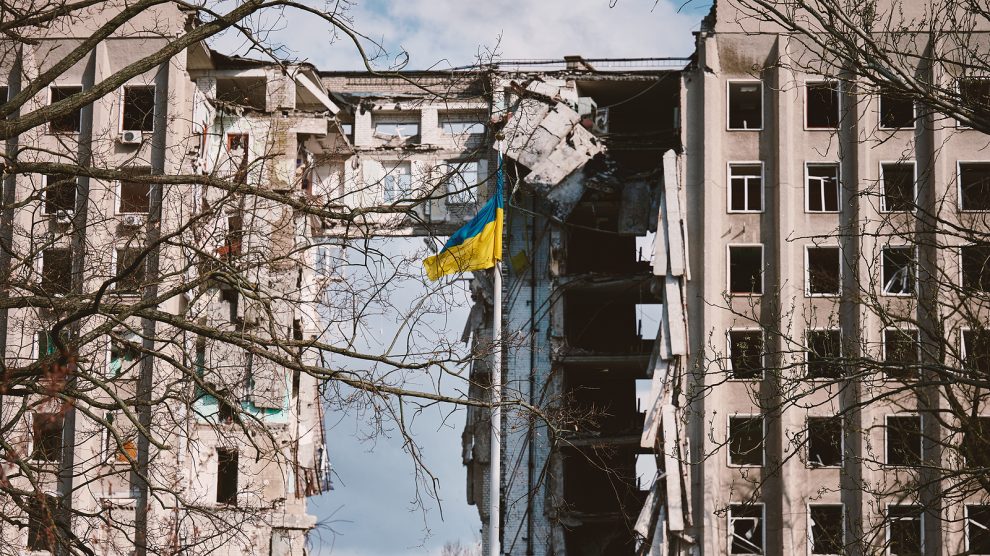For Ukraine to recover within five years, its economy would need to grow by 14 per cent a year throughout that period.
A five-year economic recovery in Ukraine would require extra investment of around 50 billion US dollars per year from inflows of capital from abroad, including private capital, according to the European Bank for Reconstruction and Development (EBRD).
In its latest Regional Economic Prospects report, the EBRD sets out a scenario for Ukraine, drawing on the lessons of history, which demonstrates that a swift recovery is not the norm.
- The last word: Ukraine’s tech sector is the epitome of business resilience
- Countries that bolster and protect human capital will better withstand future economic shock
- Freedom on Fire – The new documentary by Evgeny Afineevsky
Historically, most economies emerging from an armed conflict neither enjoy 25 years of lasting peace afterwards nor recover to their pre-war trend level of income per capita, even in the long term.
However, the report says that 29 per cent of economies do achieve their pre-war trend level of gross domestic product (GDP) per capita within five years. This research combines common features of successful reconstructions that could guide Ukraine and extrapolates pre-war trends based on the performance of economies similar to those at war.
For Ukraine to recover within five years, its economy would need to grow by 14 per cent a year throughout that period. This would raise average GDP to 225 billion US dollars from around 150 billion US dollars in 2022, in constant prices.
The main feature that periods of sustained, exceptionally high economic growth have in common is high ratios of investment to GDP.
Before the war, moderate levels of investment in Ukraine were mostly financed by domestic savings. Inflows of capital amounted to just three per cent of GDP a year from 2010-21. And foreign direct investment typically drops substantially after a conflict and takes a long time to recover. When domestic savings were low, foreign financing helped sustain a number of investment booms, including in central and south-eastern Europe in the 2000s.
In Ukraine’s case, doubling its levels of investment (as a share of GDP) would require a major increase in the country’s absorption capacity, including governance structures needed to design and contract out complex projects. It would also require appropriate financing.
“In this scenario, the difference between the required levels of investment and the available domestic savings would likely need to be covered by external financing (net inflows of capital), to the tune of 20 per cent of GDP or 50 billion US dollars per annum,” the report says.
Private and public investment must be complementary
The report by the bank, which is Ukraine’s biggest institutional investor, also stresses the importance in earlier post-conflict reconstructions of an appropriate balance of private and public sector involvement, along with the important role played by external assistance from bilateral and multilateral agencies.
“Private and public investment tend to be highly complementary, in the post-conflict situation and more generally. Beyond financing, the private sector contributes much-needed technological expertise, management know-how and a focus on cost-efficiency,” the report says, adding, “In addition to the energy-efficient industrial capital stock and agricultural machinery, the private sector can make an important contribution to rebuilding housing stock as well as transport, energy and municipal infrastructure, provided that individuals and firms have adequate access to finance.”
The report also touches on the usefulness of foreign assistance both in alleviating short-term funding shortages and in enforcing reform conditionality.
The absence of such impetus for reform and of wider efforts at building robust economic and political institutions, it adds, may obstruct private investment, leaving “bureaucratic gridlock, corruption or a high degree of informality caused by an institutional vacuum”.

Growth prospects across the EBRD regions
In its latest economic forecasts, the bank, which is this week holding its annual meeting in the Uzbek city of Samarkand, says that Ukraine’s economy is expected to grow only modestly in 2023, by one per cent, and three per cent in 2024, as businesses adapt to war circumstances.
Growth in Central Asia is forecast to remain strong, at 5.2 per cent in 2023 and 5.4 per cent in 2024, with the relocation of Russian businesses and increased oil exports boosting growth in Kazakhstan.
Output in Central Europe and the Baltic states meanwhile is expected to grow by a modest 0.5 per cent in 2023 amid slower-than-expected growth in advanced economies and persistent core inflation. While the region proved resilient in 2022, the post-Covid recovery has largely run out of steam and growth has recently turned negative in quarter-on-quarter terms. Growth is expected to pick up to 2.9 per cent in 2024.
Growth is also expected to decelerate in Eastern Europe and the Caucasus (excluding Ukraine) as the extraordinary factors that boosted economic activity in 2022 provide limited additional stimulus. The region as a whole is forecast to grow by 1.9 per cent in 2023 and 3.3 per cent in 2024.
Growth forecasts for 2023 have been revised up for the south-eastern European Union economies, supported by the prospect of eurozone accession boosting investor confidence in Bulgaria, higher public investment in Romania. The region is expected to grow by 2.3 per cent in 2023 and 3 per cent in 2024.
Output in the Western Balkans is forecast to expand at a rate of 2.2 per cent in 2023 amid headwinds from inflationary pressures and a subdued outlook for the advanced economies in Europe, before picking up to 3.4 per cent in 2024.
Unlike many news and information platforms, Emerging Europe is free to read, and always will be. There is no paywall here. We are independent, not affiliated with nor representing any political party or business organisation. We want the very best for emerging Europe, nothing more, nothing less. Your support will help us continue to spread the word about this amazing region.
You can contribute here. Thank you.







Add Comment